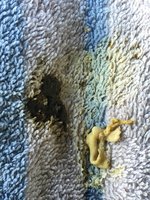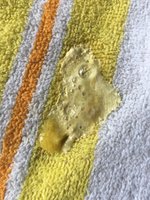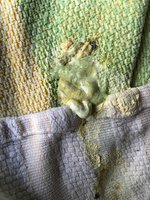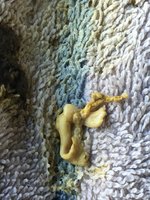ChickenMama308
Songster
- Mar 17, 2018
- 123
- 72
- 101
Hi everyone, so 10/27 I took Nani to the vet and sadly received an EYP diagnosis, exactly 3 weeks after I discovered something was off with her and along the way I've treated her for many different things trying to rule it all out. (She is a 2.5 y/o RIR who free ranges 24/7 and I don't even see, let alone collect/eat her eggs anymore and haven't for at least 6 months)
In case the info of her journey is helpful, the original post on 10/23 I made was is here:
https://www.backyardchickens.com/th...p-cocci-diarrhea.1278010/page-2#post-20577259
The second I made on 10/24 was here:
https://www.backyardchickens.com/th...everely-underweight-hen-how-to-treat.1278120/
In a nustshell, she was treated for either obvious or uncertain: lice, coccidiosis, worms, diarrhea, emaciation, crop issues, and now EYP.
At this point, I'm just trying to understand EYP - and where Nani is at in her journey with it, assuming it is a correct diagnosis. Her major symptoms right now are:
- emaciation (currently at 2.10 pounds.. less than half of her normal body weight)
- mostly liquidy poo, somewhat like egg yolk with little or no feces and yellow tint.
- weakness, lethargic
- eating / drinking very little
- crop never seems to go down 100%, though when my vet checked it via tube he said it was empty
- last night her crop kept re-filling with air after I had fed her and gave her medicine / water orally via syringe. I burped her 3-4x by massaging her crop, only to have her crop re-fill like a balloon. Still trying to figure out what that means?
- today her skin on her face is flaking off.
- her comb and face have been pale again for the past 2 days, before that it was bright red.
- She has been scratching her eyes, face and comb a lot
- She has this weird neck twitch..turning her head to the left and it turning back and forth in a way that seems involuntary. happens a lot whenever she has gone to drink water and sometimes when she does go to eat, or sometimes just randomly.
- the only things she has voluntarily eaten the past few days here and there have been spinach, papaya, and today some meal worms.
- One positive thing today was that she preened her feathers for the first time that I have witnessed in almost 3 weeks.
Questions:
I read that EYP is caused either initially by some bacteria, or ovarian cancer. How does the bacteria end up in the oviduct in the first place? In theory, is it possible to kill off all the initial + extended bacteria that causes the inflammation that causes the internal laying that causes the EYP? My vet said he honestly has little experience with/treating EYP - he didn't even drain her yolks which I definitely regret. I asked him too, if he could do it in a sterile way and he said that was not possible and that he wouldn't be able to drain all of it anyway. I only later realized that he had in fact pierced through her abdomen to receive the yolk fluid - might as well have got more, right? He did tell me there is a small chance that he pierced through a soft shell egg or something but he couldn't detect that via ultrasound. He never tested the yolk for any sign of bacteria so that is uncertain. The interesting thing is that Nani has no visible/tangible abdominal swelling... that must be a good thing, right? Because she is so underweight.. I doubt that she is ovulating right now, but just in case I am making sure that she gets 12+ hours of darkness each night here in the house to prevent her from producing more yolks. The vet said he saw what looked like one yolk in her abdomen. Is there a chance that she is just internally laying, and that it is not yet EYP? I'm confused what the difference between the two are.. because from what I understand EYP can either be sterile or non-sterile, so what's the difference between internal laying and sterile EYP?
I've just been trying to tie into the picture somehow her cause for being skin and bones underweight.. I saw some post saying that ovarian cancer can block the intestines and cause digestive issues.. is that possibly what's going on? Maybe she just has a slow crop, or slow gizzard? The vet said EYP can 'back things up' but I'm trying to understand how/why. Or is something separate happening? Her lack of eating / drinking, her weight and her mysterious crop functionings are making me wonder what's happening there or how it's all connected. Today for the first time, it actually felt doughy. Before then it's mostly been soft and squishy, non-existent like twice, and very firm a couple mornings. Again, she's eating very little.
We just started her on antibiotics and inflammatories yesterday, so waiting to see if that makes any difference for her - which would mean it's bacterial based, correct? But there's a chance it is caused by a virus that doesn't react, if I understand correctly. Also the chance of ovarian cancer, which RIR get frequently, as well as any reproductive disease unfortunately, from what I have read.
I was planning to give her an epsom salt bath now, a blow dry session and an epsom salt enema, then of course her medicine tonight. As I am new to this, any tips / insights / thoughts based off what I have wrote so far would be super appreciated. I want to give her a chance to see this through, but if I believe she is just suffering, then I will take her back to the vet to put her to rest. Please let me know what else to try as I love her very much and would prefer to get her back to health and well-being - thank you <3
- also, does anyone recommend specific probiotics and/or digestive enzymes for her?
In case the info of her journey is helpful, the original post on 10/23 I made was is here:
https://www.backyardchickens.com/th...p-cocci-diarrhea.1278010/page-2#post-20577259
The second I made on 10/24 was here:
https://www.backyardchickens.com/th...everely-underweight-hen-how-to-treat.1278120/
In a nustshell, she was treated for either obvious or uncertain: lice, coccidiosis, worms, diarrhea, emaciation, crop issues, and now EYP.
At this point, I'm just trying to understand EYP - and where Nani is at in her journey with it, assuming it is a correct diagnosis. Her major symptoms right now are:
- emaciation (currently at 2.10 pounds.. less than half of her normal body weight)
- mostly liquidy poo, somewhat like egg yolk with little or no feces and yellow tint.
- weakness, lethargic
- eating / drinking very little
- crop never seems to go down 100%, though when my vet checked it via tube he said it was empty
- last night her crop kept re-filling with air after I had fed her and gave her medicine / water orally via syringe. I burped her 3-4x by massaging her crop, only to have her crop re-fill like a balloon. Still trying to figure out what that means?
- today her skin on her face is flaking off.
- her comb and face have been pale again for the past 2 days, before that it was bright red.
- She has been scratching her eyes, face and comb a lot
- She has this weird neck twitch..turning her head to the left and it turning back and forth in a way that seems involuntary. happens a lot whenever she has gone to drink water and sometimes when she does go to eat, or sometimes just randomly.
- the only things she has voluntarily eaten the past few days here and there have been spinach, papaya, and today some meal worms.
- One positive thing today was that she preened her feathers for the first time that I have witnessed in almost 3 weeks.
Questions:
I read that EYP is caused either initially by some bacteria, or ovarian cancer. How does the bacteria end up in the oviduct in the first place? In theory, is it possible to kill off all the initial + extended bacteria that causes the inflammation that causes the internal laying that causes the EYP? My vet said he honestly has little experience with/treating EYP - he didn't even drain her yolks which I definitely regret. I asked him too, if he could do it in a sterile way and he said that was not possible and that he wouldn't be able to drain all of it anyway. I only later realized that he had in fact pierced through her abdomen to receive the yolk fluid - might as well have got more, right? He did tell me there is a small chance that he pierced through a soft shell egg or something but he couldn't detect that via ultrasound. He never tested the yolk for any sign of bacteria so that is uncertain. The interesting thing is that Nani has no visible/tangible abdominal swelling... that must be a good thing, right? Because she is so underweight.. I doubt that she is ovulating right now, but just in case I am making sure that she gets 12+ hours of darkness each night here in the house to prevent her from producing more yolks. The vet said he saw what looked like one yolk in her abdomen. Is there a chance that she is just internally laying, and that it is not yet EYP? I'm confused what the difference between the two are.. because from what I understand EYP can either be sterile or non-sterile, so what's the difference between internal laying and sterile EYP?
I've just been trying to tie into the picture somehow her cause for being skin and bones underweight.. I saw some post saying that ovarian cancer can block the intestines and cause digestive issues.. is that possibly what's going on? Maybe she just has a slow crop, or slow gizzard? The vet said EYP can 'back things up' but I'm trying to understand how/why. Or is something separate happening? Her lack of eating / drinking, her weight and her mysterious crop functionings are making me wonder what's happening there or how it's all connected. Today for the first time, it actually felt doughy. Before then it's mostly been soft and squishy, non-existent like twice, and very firm a couple mornings. Again, she's eating very little.
We just started her on antibiotics and inflammatories yesterday, so waiting to see if that makes any difference for her - which would mean it's bacterial based, correct? But there's a chance it is caused by a virus that doesn't react, if I understand correctly. Also the chance of ovarian cancer, which RIR get frequently, as well as any reproductive disease unfortunately, from what I have read.
I was planning to give her an epsom salt bath now, a blow dry session and an epsom salt enema, then of course her medicine tonight. As I am new to this, any tips / insights / thoughts based off what I have wrote so far would be super appreciated. I want to give her a chance to see this through, but if I believe she is just suffering, then I will take her back to the vet to put her to rest. Please let me know what else to try as I love her very much and would prefer to get her back to health and well-being - thank you <3
- also, does anyone recommend specific probiotics and/or digestive enzymes for her?
Last edited:




 and yes, Nani is only 2.5 years old and is from a hatchery. I’m trying to make my best guess at whether it may be salpingitis - though she has never laid a lash egg she has passed little fleshy bits that could potentially be lash material. I can’t feel any abdominal swelling in her right now. Attached are some of the most suspect photos of her poo along the way... a couple of them have what others believe may be lash material.
and yes, Nani is only 2.5 years old and is from a hatchery. I’m trying to make my best guess at whether it may be salpingitis - though she has never laid a lash egg she has passed little fleshy bits that could potentially be lash material. I can’t feel any abdominal swelling in her right now. Attached are some of the most suspect photos of her poo along the way... a couple of them have what others believe may be lash material.




